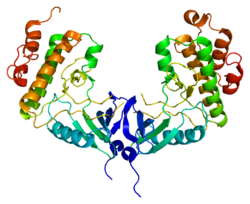Protein-coding gene in the species Homo sapiens
MAP kinase-interacting serine/threonine-protein kinase 1 is an enzyme that in humans is encoded by the MKNK1 gene .[5] [6]
Interactions MKNK1 has been shown to interact with MAPK1 [7] Eukaryotic translation initiation factor 4 gamma .[8]
References
^ a b c GRCh38: Ensembl release 89: ENSG00000079277 – Ensembl , May 2017^ a b c GRCm38: Ensembl release 89: ENSMUSG00000028708 – Ensembl , May 2017^ "Human PubMed Reference:" . National Center for Biotechnology Information, U.S. National Library of Medicine .^ "Mouse PubMed Reference:" . National Center for Biotechnology Information, U.S. National Library of Medicine .^ Fukunaga R, Hunter T (Jun 1997). "MNK1, a new MAP kinase-activated protein kinase, isolated by a novel expression screening method for identifying protein kinase substrates" . EMBO J . 16 (8): 1921–33. doi :10.1093/emboj/16.8.1921 . PMC 1169795 PMID 9155018 . ^ "Entrez Gene: MKNK1 MAP kinase interacting serine/threonine kinase 1" .^ Waskiewicz AJ, Flynn A, Proud C G, Cooper J A (Apr 1997). "Mitogen-activated protein kinases activate the serine/threonine kinases Mnk1 and Mnk2" . EMBO J . 16 (8). ENGLAND: 1909–20. doi :10.1093/emboj/16.8.1909 . ISSN 0261-4189 . PMC 1169794 PMID 9155017 . ^ Pyronnet S, Imataka H, Gingras A C, Fukunaga R, Hunter T, Sonenberg N (Jan 1999). "Human eukaryotic translation initiation factor 4G (eIF4G) recruits mnk1 to phosphorylate eIF4E" . EMBO J . 18 (1). ENGLAND: 270–9. doi :10.1093/emboj/18.1.270 . ISSN 0261-4189 . PMC 1171121 PMID 9878069 .
Further reading
de Carvalho MG, McCormack AL, Olson E, et al. (1996). "Identification of phosphorylation sites of human 85-kDa cytosolic phospholipase A2 expressed in insect cells and present in human monocytes" . J. Biol. Chem . 271 (12): 6987–97. doi :10.1074/jbc.271.12.6987 PMID 8636128 . Waskiewicz AJ, Flynn A, Proud CG, Cooper JA (1997). "Mitogen-activated protein kinases activate the serine/threonine kinases Mnk1 and Mnk2" . EMBO J . 16 (8): 1909–20. doi :10.1093/emboj/16.8.1909 . PMC 1169794 PMID 9155017 . Börsch-Haubold AG, Bartoli F, Asselin J, et al. (1998). "Identification of the phosphorylation sites of cytosolic phospholipase A2 in agonist-stimulated human platelets and HeLa cells" . J. Biol. Chem . 273 (8): 4449–58. doi :10.1074/jbc.273.8.4449 PMID 9468497 . Pyronnet S, Imataka H, Gingras AC, et al. (1999). "Human eukaryotic translation initiation factor 4G (eIF4G) recruits mnk1 to phosphorylate eIF4E" . EMBO J . 18 (1): 270–9. doi :10.1093/emboj/18.1.270 . PMC 1171121 PMID 9878069 . Waskiewicz AJ, Johnson JC, Penn B, et al. (1999). "Phosphorylation of the cap-binding protein eukaryotic translation initiation factor 4E by protein kinase Mnk1 in vivo" . Mol. Cell. Biol . 19 (3): 1871–80. doi :10.1128/MCB.19.3.1871 . PMC 83980 PMID 10022874 . Cuesta R, Laroia G, Schneider RJ (2000). "Chaperone hsp27 inhibits translation during heat shock by binding eIF4G and facilitating dissociation of cap-initiation complexes" . Genes Dev . 14 (12): 1460–70. doi :10.1101/gad.14.12.1460 . PMC 316692 PMID 10859165 . Hefner Y, Borsch-Haubold AG, Murakami M, et al. (2001). "Serine 727 phosphorylation and activation of cytosolic phospholipase A2 by MNK1-related protein kinases" . J. Biol. Chem . 275 (48): 37542–51. doi :10.1074/jbc.M003395200 PMID 10978317 . Scheper GC, Morrice NA, Kleijn M, Proud CG (2001). "The mitogen-activated protein kinase signal-integrating kinase Mnk2 is a eukaryotic initiation factor 4E kinase with high levels of basal activity in mammalian cells" . Mol. Cell. Biol . 21 (3): 743–54. doi :10.1128/MCB.21.3.743-754.2001 . PMC 86666 PMID 11154262 . Knauf U, Tschopp C, Gram H (2001). "Negative regulation of protein translation by mitogen-activated protein kinase-interacting kinases 1 and 2" . Mol. Cell. Biol . 21 (16): 5500–11. doi :10.1128/MCB.21.16.5500-5511.2001 . PMC 87272 PMID 11463832 . Strausberg RL, Feingold EA, Grouse LH, et al. (2003). "Generation and initial analysis of more than 15,000 full-length human and mouse cDNA sequences" . Proc. Natl. Acad. Sci. U.S.A . 99 (26): 16899–903. Bibcode :2002PNAS...9916899M . doi :10.1073/pnas.242603899 PMC 139241 PMID 12477932 . Reuter TY, Medhurst AL, Waisfisz Q, et al. (2003). "Yeast two-hybrid screens imply involvement of Fanconi anemia proteins in transcription regulation, cell signaling, oxidative metabolism, and cellular transport". Exp. Cell Res . 289 (2): 211–21. doi :10.1016/S0014-4827(03)00261-1 . PMID 14499622 . Ota T, Suzuki Y, Nishikawa T, et al. (2004). "Complete sequencing and characterization of 21,243 full-length human cDNAs" . Nat. Genet . 36 (1): 40–5. doi :10.1038/ng1285 PMID 14702039 . Cuesta R, Xi Q, Schneider RJ (2004). "Structural basis for competitive inhibition of eIF4G-Mnk1 interaction by the adenovirus 100-kilodalton protein" . J. Virol . 78 (14): 7707–16. doi :10.1128/JVI.78.14.7707-7716.2004 . PMC 434077 PMID 15220445 . Orton KC, Ling J, Waskiewicz AJ, et al. (2004). "Phosphorylation of Mnk1 by caspase-activated Pak2/gamma-PAK inhibits phosphorylation and interaction of eIF4G with Mnk" . J. Biol. Chem . 279 (37): 38649–57. doi :10.1074/jbc.M407337200 PMID 15234964 . O'Loghlen A, González VM, Piñeiro D, et al. (2004). "Identification and molecular characterization of Mnk1b, a splice variant of human MAP kinase-interacting kinase Mnk1". Exp. Cell Res . 299 (2): 343–55. doi :10.1016/j.yexcr.2004.06.006 . PMID 15350534 . Gerhard DS, Wagner L, Feingold EA, et al. (2004). "The status, quality, and expansion of the NIH full-length cDNA project: the Mammalian Gene Collection (MGC)" . Genome Res . 14 (10B): 2121–7. doi :10.1101/gr.2596504 . PMC 528928 PMID 15489334 . Worch J, Tickenbrock L, Schwäble J, et al. (2005). "The serine-threonine kinase MNK1 is post-translationally stabilized by PML-RARalpha and regulates differentiation of hematopoietic cells". Oncogene . 23 (57): 9162–72. doi :10.1038/sj.onc.1208164 . PMID 15516979 . S2CID 25123414 . Grund EM, Spyropoulos DD, Watson DK, Muise-Helmericks RC (2005). "Interleukins 2 and 15 regulate Ets1 expression via ERK1/2 and MNK1 in human natural killer cells" . J. Biol. Chem . 280 (6): 4772–8. doi :10.1074/jbc.M408356200 PMID 15563472 . O'Loghlen A, González VM, Salinas M, Martín ME (2005). "Suppression of human Mnk1 by small interfering RNA increases the eukaryotic initiation factor 4F activity in HEK293T cells". FEBS Lett . 578 (1–2): 31–5. doi :10.1016/j.febslet.2004.10.063 . PMID 15581611 . S2CID 28489044 .
Activity Regulation Classification Kinetics Types






